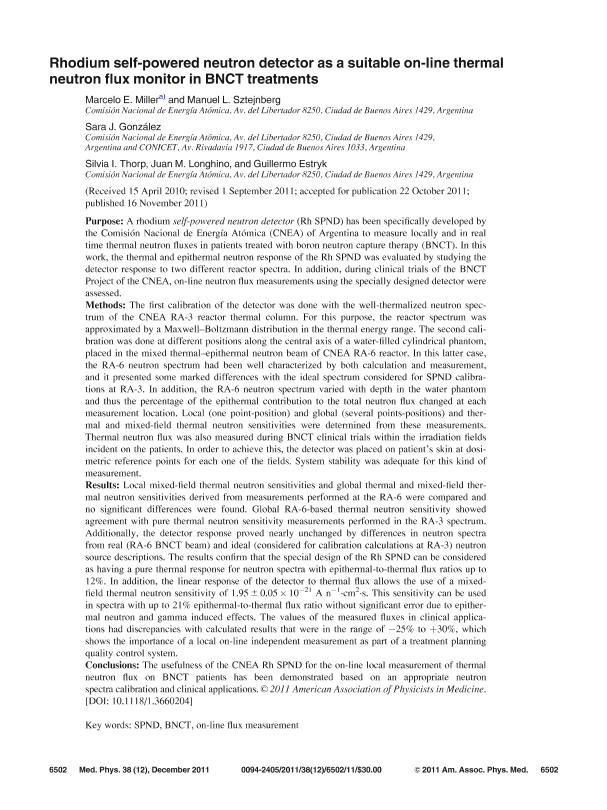Mostrar el registro sencillo del ítem
dc.contributor.author
Miller, Marcelo Eduardo

dc.contributor.author
Sztejnberg, Manuel L.
dc.contributor.author
González, Sara Josefina

dc.contributor.author
Thorp, Silvia Inés

dc.contributor.author
Longhino, Juan Manuel

dc.contributor.author
Estryk, Guillermo
dc.date.available
2023-04-19T10:42:26Z
dc.date.issued
2011-12
dc.identifier.citation
Miller, Marcelo Eduardo; Sztejnberg, Manuel L.; González, Sara Josefina; Thorp, Silvia Inés; Longhino, Juan Manuel; et al.; Rhodium self-powered neutron detector as a suitable on-line thermal neutron flux monitor in BNCT treatments; American Association of Physicists in Medicine; Medical Physics; 38; 12; 12-2011; 6502-6512
dc.identifier.issn
0094-2405
dc.identifier.uri
http://hdl.handle.net/11336/194451
dc.description.abstract
A rhodium self-powered neutron detector (Rh SPND) has been specifically developed by the Comisión Nacional de Energía Atómica (CNEA) of Argentina to measure locally and in real time thermal neutron fluxes in patients treated with boron neutron capture therapy (BNCT). In this work, the thermal and epithermal neutron response of the Rh SPND was evaluated by studying the detector response to two different reactor spectra. In addition, during clinical trials of the BNCT Project of the CNEA, on-line neutron flux measurements using the specially designed detector were assessed. The first calibration of the detector was done with the well-thermalized neutron spectrum of the CNEA RA-3 reactor thermal column. For this purpose, the reactor spectrum was approximated by a Maxwell-Boltzmann distribution in the thermal energy range. The second calibration was done at different positions along the central axis of a water-filled cylindrical phantom, placed in the mixed thermal-epithermal neutron beam of CNEA RA-6 reactor. In this latter case, the RA-6 neutron spectrum had been well characterized by both calculation and measurement, and it presented some marked differences with the ideal spectrum considered for SPND calibrations at RA-3. In addition, the RA-6 neutron spectrum varied with depth in the water phantom and thus the percentage of the epithermal contribution to the total neutron flux changed at each measurement location. Local (one point-position) and global (several points-positions) and thermal and mixed-field thermal neutron sensitivities were determined from these measurements. Thermal neutron flux was also measured during BNCT clinical trials within the irradiation fields incident on the patients. In order to achieve this, the detector was placed on patient´s skin at dosimetric reference points for each one of the fields. System stability was adequate for this kind of measurement. Local mixed-field thermal neutron sensitivities and global thermal and mixed-field thermal neutron sensitivities derived from measurements performed at the RA-6 were compared and no significant differences were found. Global RA-6-based thermal neutron sensitivity showed agreement with pure thermal neutron sensitivity measurements performed in the RA-3 spectrum. Additionally, the detector response proved nearly unchanged by differences in neutron spectra from real (RA-6 BNCT beam) and ideal (considered for calibration calculations at RA-3) neutron source descriptions. The results confirm that the special design of the Rh SPND can be considered as having a pure thermal response for neutron spectra with epithermal-to-thermal flux ratios up to 12%. In addition, the linear response of the detector to thermal flux allows the use of a mixed-field thermal neutron sensitivity of 1.95 ± 0.05 × 10(-21) A n(-1)[middle dot]cm² [middle dot]s. This sensitivity can be used in spectra with up to 21% epithermal-to-thermal flux ratio without significant error due to epithermal neutron and gamma induced effects. The values of the measured fluxes in clinical applications had discrepancies with calculated results that were in the range of -25% to +30%, which shows the importance of a local on-line independent measurement as part of a treatment planning quality control system. The usefulness of the CNEA Rh SPND for the on-line local measurement of thermal neutron flux on BNCT patients has been demonstrated based on an appropriate neutron spectra calibration and clinical applications.
dc.format
application/pdf
dc.language.iso
eng
dc.publisher
American Association of Physicists in Medicine

dc.rights
info:eu-repo/semantics/openAccess
dc.rights.uri
https://creativecommons.org/licenses/by-nc-sa/2.5/ar/
dc.subject
BNCT
dc.subject
ON-LINE FLUX MEASUREMENT
dc.subject
SPND
dc.subject.classification
Otras Ingenierías y Tecnologías

dc.subject.classification
Otras Ingenierías y Tecnologías

dc.subject.classification
INGENIERÍAS Y TECNOLOGÍAS

dc.title
Rhodium self-powered neutron detector as a suitable on-line thermal neutron flux monitor in BNCT treatments
dc.type
info:eu-repo/semantics/article
dc.type
info:ar-repo/semantics/artículo
dc.type
info:eu-repo/semantics/publishedVersion
dc.date.updated
2023-04-18T13:08:35Z
dc.journal.volume
38
dc.journal.number
12
dc.journal.pagination
6502-6512
dc.journal.pais
Estados Unidos

dc.description.fil
Fil: Miller, Marcelo Eduardo. Comisión Nacional de Energía Atómica; Argentina
dc.description.fil
Fil: Sztejnberg, Manuel L.. Comisión Nacional de Energía Atómica; Argentina
dc.description.fil
Fil: González, Sara Josefina. Comisión Nacional de Energía Atómica; Argentina. Consejo Nacional de Investigaciones Científicas y Técnicas; Argentina
dc.description.fil
Fil: Thorp, Silvia Inés. Comisión Nacional de Energía Atómica; Argentina
dc.description.fil
Fil: Longhino, Juan Manuel. Comisión Nacional de Energía Atómica; Argentina
dc.description.fil
Fil: Estryk, Guillermo. Comisión Nacional de Energía Atómica; Argentina
dc.journal.title
Medical Physics

dc.relation.alternativeid
info:eu-repo/semantics/altIdentifier/url/https://aapm.onlinelibrary.wiley.com/doi/full/10.1118/1.3660204
dc.relation.alternativeid
info:eu-repo/semantics/altIdentifier/doi/http://dx.doi.org/10.1118/1.3660204
Archivos asociados
